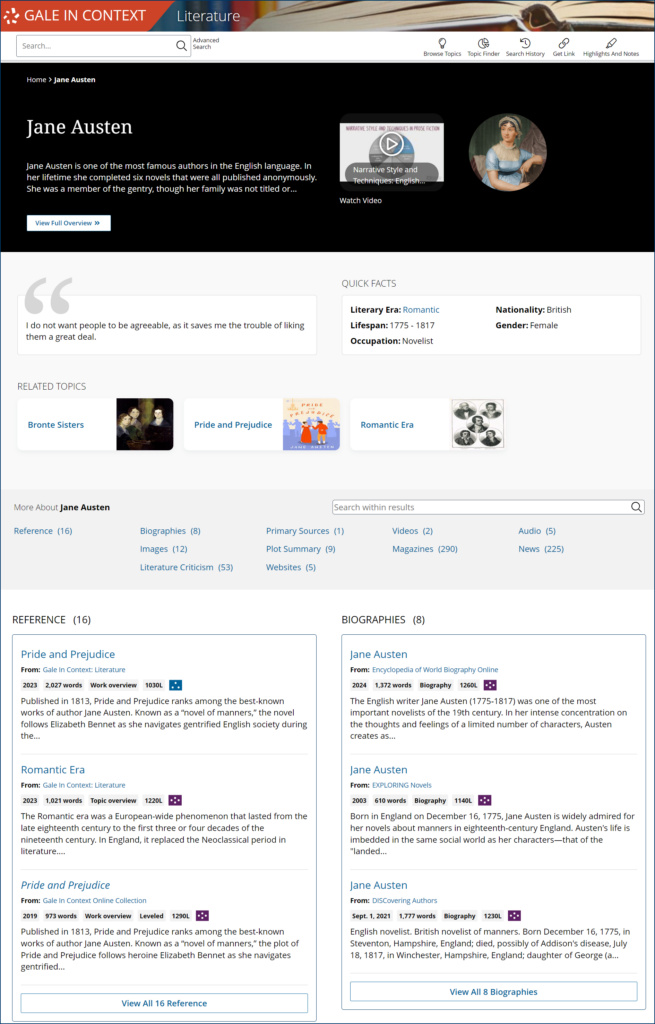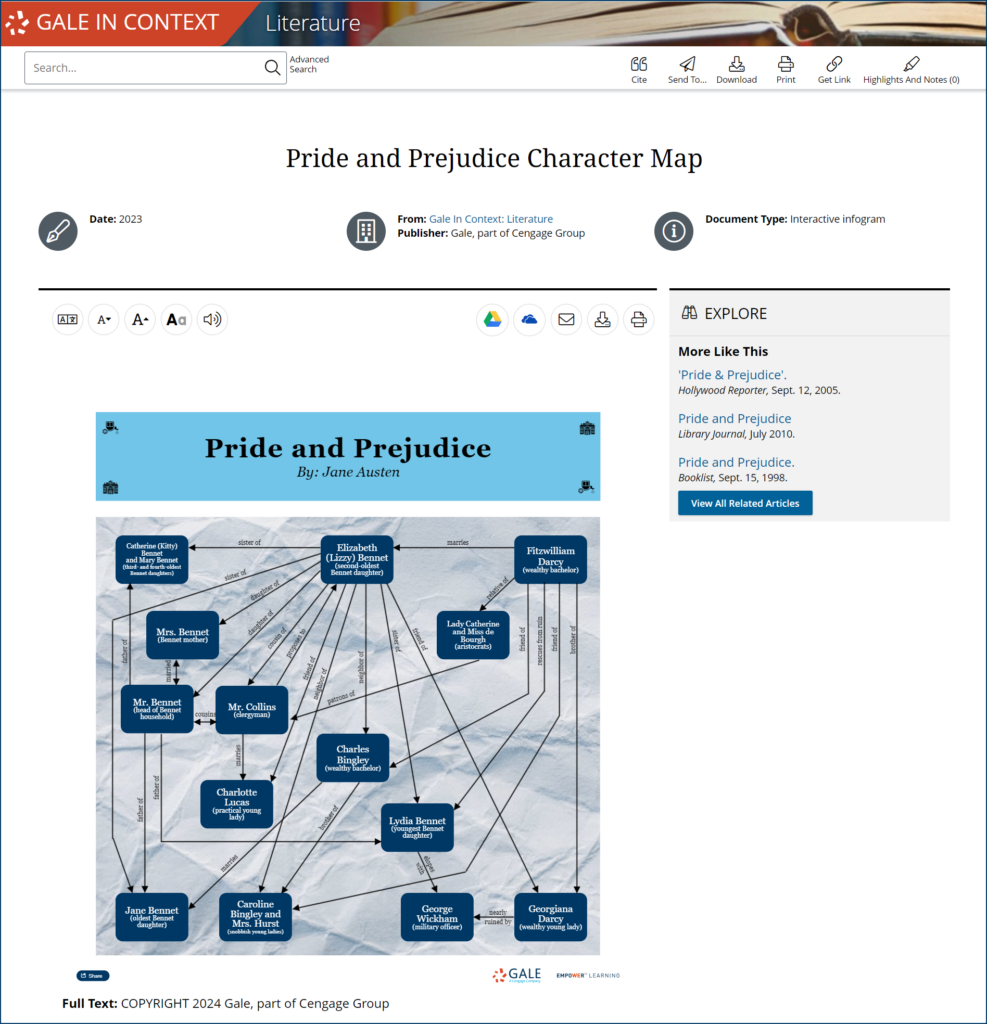| By Gale Staff |
Do you remember the first time you picked up a Jane Austen novel?
Her stories have remained widely read and relevant for centuries. There are more than 17 film adaptations of Pride and Prejudice alone—and plenty of quirky reimaginings, such as the popular 2009 novel, Pride and Prejudice and Zombies. Austen was a prolific author whose characters, both major and minor, stick with readers well after turning the final page.
Jane Austen was born on December 16, 1775. To celebrate her birthday, consider introducing her to your class before assigning one of her novels for some reading over the winter break. Gale In Context: Literature can help your classes explore popular texts through a diverse database of related resources. Our Jane Austen topic page allows students to access high-interest content within a user-friendly environment.
From her fascinating background to her most famous works and literary themes, there’s so much to explore in the world of Jane Austen. Through Gale, all students can easily make meaningful connections to classic literature.
Meet the Real Jane Austen
To get your class started, begin with Gale In Context: Literature’s Literary Overview for Austen. This comprehensive resource presents a straightforward gateway into the significant aspects of her early life, influences, major works, and ongoing literary relevance. Gale breaks information down into manageable paragraphs and features customization tools for improved literacy, including adjustable fonts, spacing, and text size. Plus, the content engages readers with related articles, thought-provoking quotes, and curious facts.
Austen was born the seventh of eight children. Her father was a clergy member, so the family lived a modest but comfortable existence. Thanks to her father’s profession, young Austen had access to books—hundreds and hundreds of them. She read through all of the greats, from Alexander Pope and William Cowper to Ann Radcliffe and William Shakespeare.
While Austen received some schooling, her bookish father was her primary teacher. Unsurprisingly, she was a voracious reader and early creative writer. At 14, she completed Love and Freindship, an entertaining parody of the period’s overdramatic representations of romance. Despite the tongue-in-cheek nature of the story (not to mention her childish misspellings), the novel shows her early promise as a thoughtful and humorous writer.
At 20, Austen drafted her first significant novel, Sense and Sensibility. The book focuses on two sisters of very different temperaments. Using melodramatic tropes, including love affairs, lost fortunes, and even a duel to death, Austen tells a timeless story of young women striking their own paths in a world dominated by gender norms and social etiquette.
Fall in Love With Pride and Prejudice
Quickly following the completion of her first novel, Austen penned First Impressions, though the title would eventually change to the better-known Pride and Prejudice. Pride and Prejudice is Austen’s masterpiece and one of the most famous love stories of all time. Whether they recognize the Colin Firth or Kiera Knightly cinematic adaptations, your students might already be familiar with the story. Published more than 200 years ago, the book is a timeless reflection on humanity within the confines of a rigid social class structure.
As a class, pivot to the Pride and Prejudice topic page in Gale In Context: Literature. You can jumpstart the discussion with our curated “Essential Questions,” or simply plunge into the full text of the novel. For more of an overview, you might also want to access a plot summary or a helpful character map.
Truth be told, Pride and Prejudice is a fairly straightforward novel. Elizabeth Bennet, an intelligent woman of modest means, meets the standoffish and wealthy Mr. Darcy. The two initially dislike one another because of prejudice embedded in their disparate social classes. Of course, amid the relatively uneventful drama of the secondary characters, the two eventually fall in love.
But what makes this particular novel stand the test of time? Using Gale In Context: Literature, navigate helpful literary criticisms to better understand the depth and balance of Austen’s writing. She captures the small, daily dramas of real life and illustrates a remarkable portrait of human nature. It’s relatable, funny, and charming—even centuries later.
Discuss Austen’s Ongoing Relevancy Today
Invite students to reflect on different types of social structures. Rather than restricting discussion to questions of class, consider if her themes resonate with disparities in terms of race, ethnicity, religion, sexual orientation, etc. Consider how Austen’s characters are flawed but ultimately possess the ability to grow and change. With humor and a touch of romance, Austen’s writing carries these themes from one generation to the next.
You don’t need to read the full anthology to identify the common themes throughout her works, such as her often scathing rebukes of rigid societal norms and gender expectations. Gale In Context: Literature can help students dig deeper into the ongoing relevance of her writing.
In addition to her thematic material, her literary style and construction were invaluable to literature. Austen pioneered the structure of the modern novel. Her focus on ordinary people’s everyday lives and emotions was groundbreaking, as was her ability to interlace a cast of minor characters into the main plot. She also developed an innovative third-person narration style that blends the thoughts and feelings of her main character, a perspective that is now pervasive throughout modern fiction.
In an ironic twist befitting the woman herself, Austen never married, nor did she rise in social standing. We know her characters’ intimate thoughts and secrets, yet we know very little about her actual life. She died at just 41, after completing seven novels and having started several others. However, they wouldn’t receive critical acclaim until well after her death (largely since she chose to publish her novels anonymously). But perhaps that’s precisely the point: an ordinary life can nonetheless leave a timeless legacy.
This December, you can rely on Gale In Context: Literature to celebrate and share this fascinating woman’s life and works with your class. If your school doesn’t subscribe to Gale In Context databases, contact your local rep today to learn more about our products.



